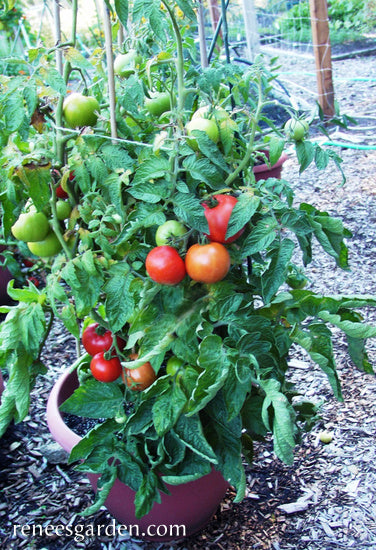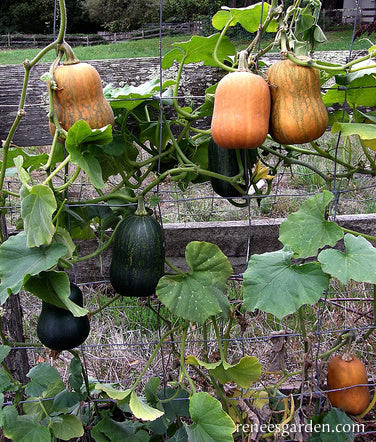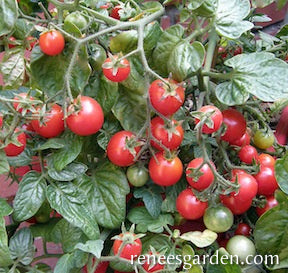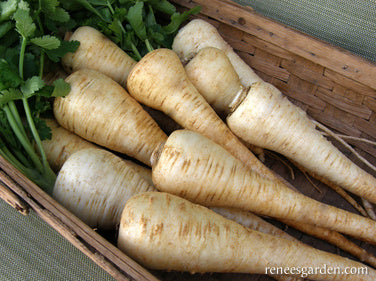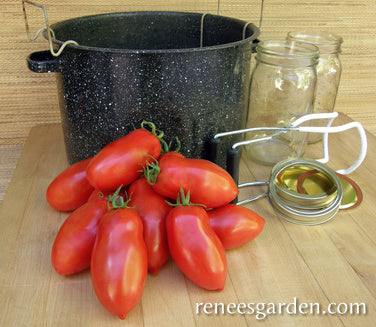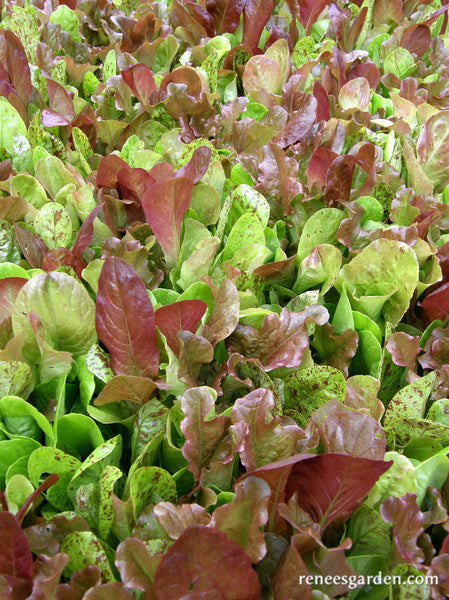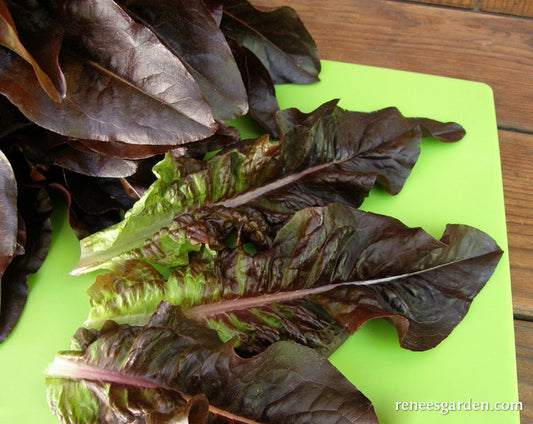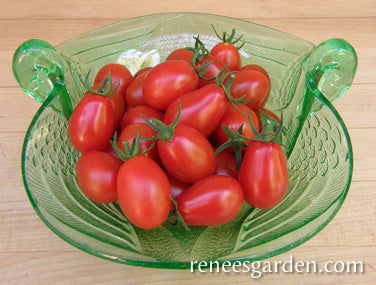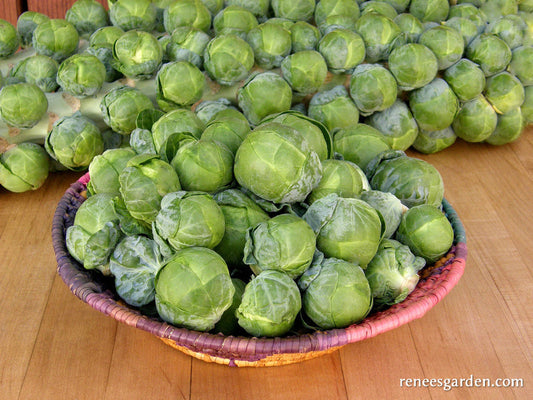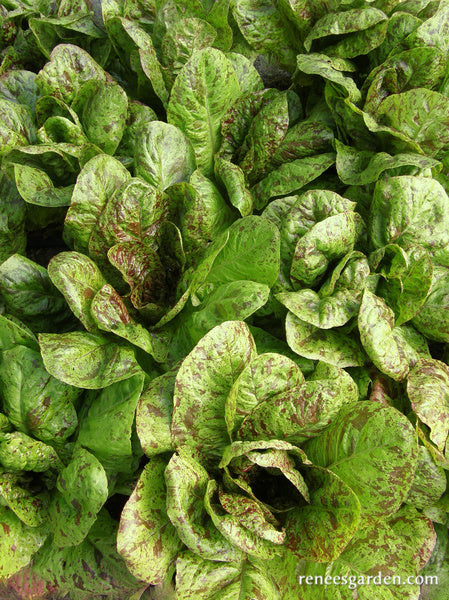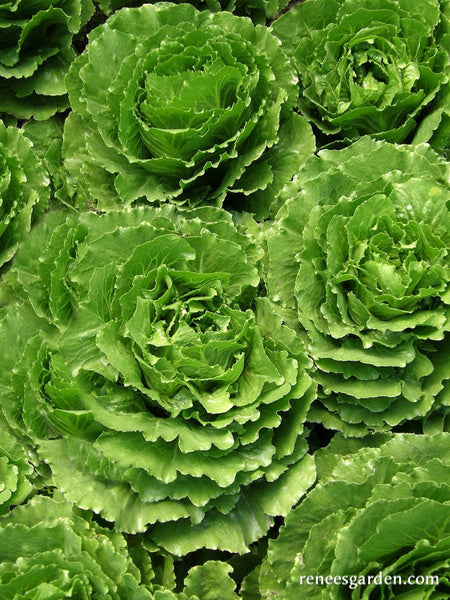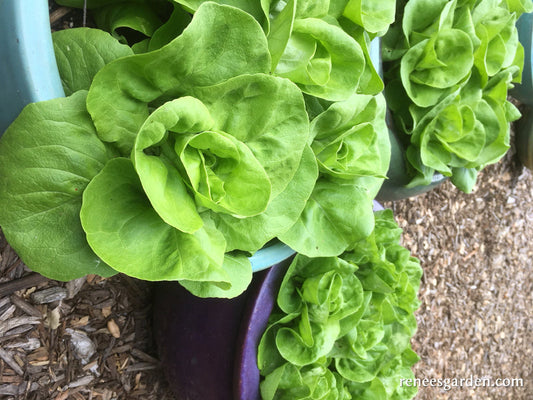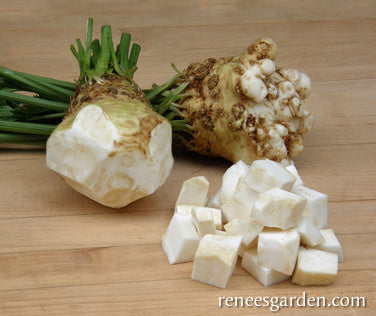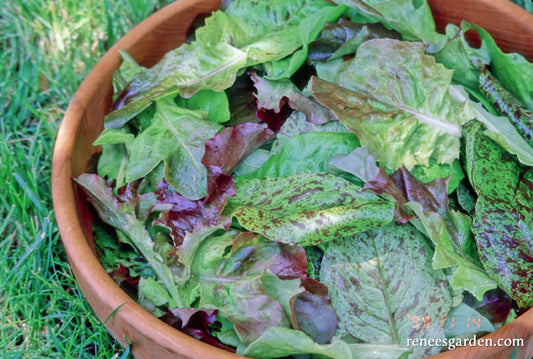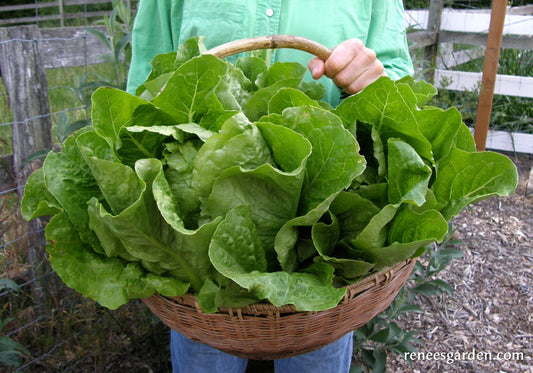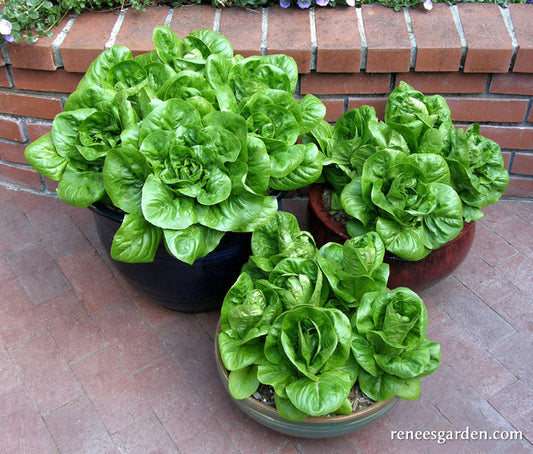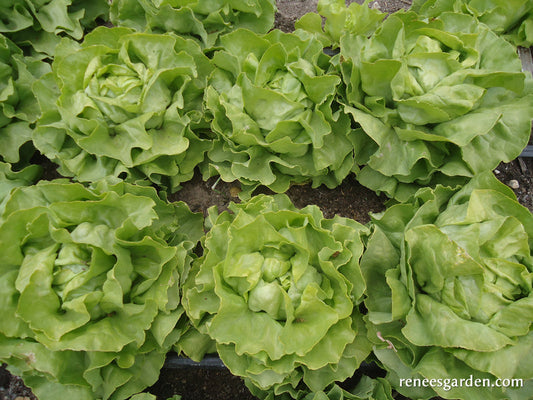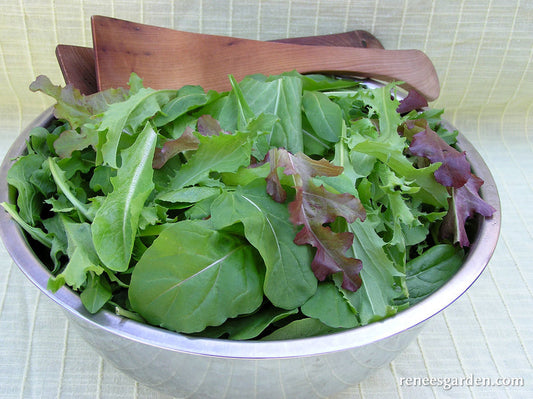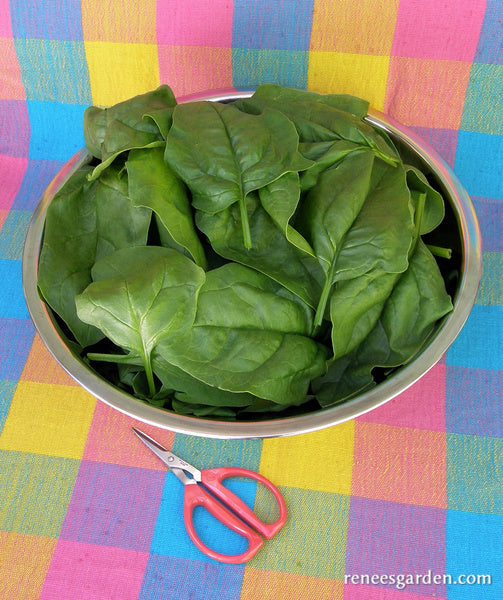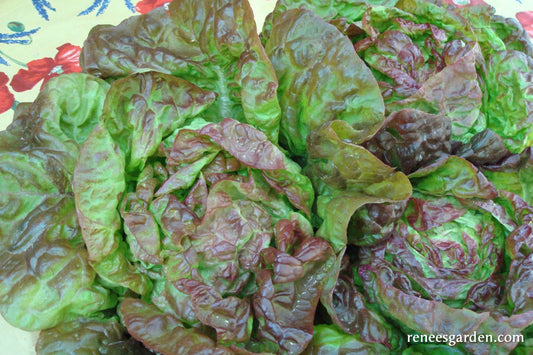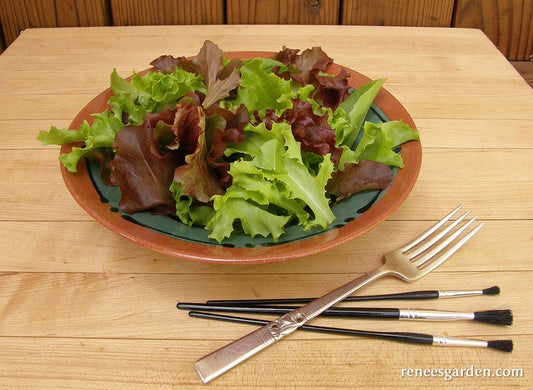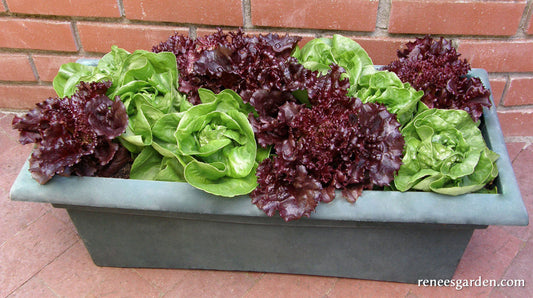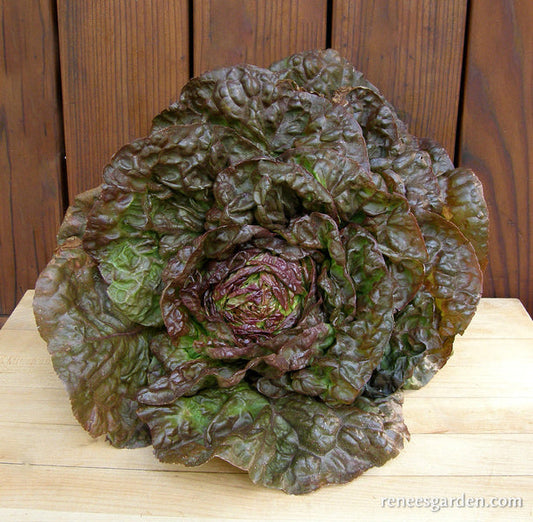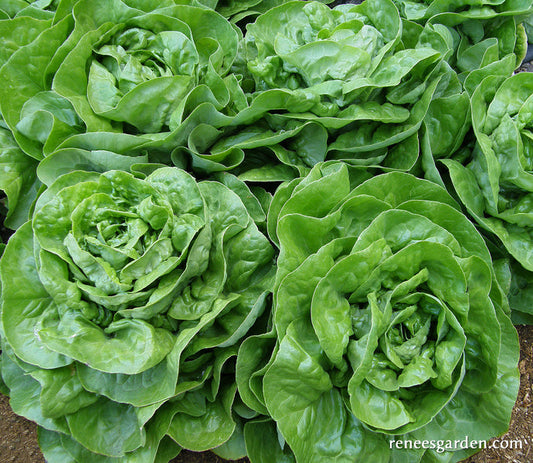Vegetables
Set The Table From Your Garden
-
Container Tomato Super Bush
STARTING SEEDLINGS
In early spring, start indoors about 6 to 8 weeks before outdoor night temperatures are reliably in the 50-55°F (10-13°C). Sow seeds 1/4 inch deep and 1 inch apart in a container of seed starting mix. Keep moist but not soggy, and very warm, 80°F (27°C). Provide a strong light source until seedlings are ready to plant outside. When seedlings are 2 inches tall, transplant into individual 4 inch pots. Maintain at 70°F (21°C). Feed with half-strength fertilizer every 2 weeks until ready to plant. When nights reach 55°F (13°C), gradually acclimate to outdoor conditions. Plant these vigorous, early bearing vines 3 feet apart into rich soil in full sun.
Grown In Containers: Transplant one seedling per pot with a minimum size of 18 to 20 inch diameter and 18 inches high. Use fresh potting mix to prevent soil borne disease. Water regularly: in hot weather, pots may need water daily. Fertilize every other week with a low nitrogen fertilizer for strong plants and good yields.
GROWING NOTES
Tomatoes need full sun at least 6 hours every day. Provide strong stakes or wire cages at planting time as plants get heavy with fruit. Mulch plants well to maintain even moisture. Pick fully ripe. Don’t store tomatoes in the fridge.
Regular price $4.99Sale price $4.99Unit price / per -
Baby Butternut Squash Climbing Honey Nut
BEST TO START OUTDOORS
Honey Nuts need full sun, rich fertile soil and warm temperatures. Wait to plant until nights are comfortably above 50°F (10°C) both day and night. Sow groups of 2 to 3 seeds 2 ft. apart and 1 in. deep in rows 4 ft. apart. Thin to 1 strong seedling per group to give vines room to ramble or climb. Or make slightly mounded hills 2 to 3 ft. across and 6 ft. apart and plant 4 to 5 seeds in each hill. When seedlings have several sets of leaves, thin to the strongest 3 seedlings per hill.
GROWING NOTES
Protect young seedlings from marauding birds by covering with plastic berry baskets at sowing time, removing before plants get crowded. To save space, and make picking easy, Honey Nut vines can easily be trained up fences, trellises or 4-6 foot tall teepees.
HARVEST AND USE
These delicious little squashes need to mature properly, so don’t harvest until vines have died back and squashes’ exterior rinds are fully colored up from dark green to orangey-tan and tough enough to resist piercing with a fingernail. Then cut squashes from vines, leaving a good stem handle. Let squashes cure in the sun for about 10 days, then store in a cool dry place and they’ll keep for months. In the kitchen, cut Honey Nuts in half then bake until tender. Flesh is meltingly sweet and delicious.Regular price $4.89Sale price $4.89Unit price / per -
Windowbox Tomatoes Litt'l Bites Cherry
STARTING SEEDLINGS
In early spring, start indoors about 6 weeks before night temperatures are reliably in the 50-55°F (10-13°C). Sow seeds 1/4 in. deep and 1 in. apart in a container of seed starting mix. Keep moist but not soggy, and very warm, 80°F (27°C). Provide a strong light source until seedlings are ready to plant outside. When seedlings are 2 in. tall, transplant into individual 4-in. pots. Maintain at 70°F (21°C). Feed with half-strength fertilizer every 2 weeks until ready to plant. When night temperatures are reliably in the 55°F (13°C) range, gradually acclimate to outdoor conditions.
Container Growing: Transplant one seedling per pot or basket that is at least 16 in. in diameter and 16 in. high. Container tomatoes need a location with at least 6 hours of sun per day. Use fresh potting mix to prevent soil borne disease. Mulch plants well and water regularly: in hot weather, pots may need water daily. Fertilize every other week with a low nitrogen fertilizer for strong plants and good yields.
HARVEST AND USE
Litt’l Bites plants cascade attractively from their containers and are soon covered with tasty little cherry tomatoes. Pick and enjoy these cute little baby tomatoes frequently when red ripe to encourage the most production. For best flavor don’t store Litt’l Bites in the fridge.Regular price $4.99Sale price $4.99Unit price / per -
English Parsnips Savour
START SEEDS DIRECTLY OUTDOORS
After all danger of frost is over in spring, sow seeds in well-worked, very fertile soil in full sun. Space seeds 1 inch apart and cover 1/2 inches deep. Make rows 10 inches apart. Be patient; parsnips germinate slowly and unevenly. Tip: Drop a radish seed every 6 inches or so to mark the row and help break the soil crust. Parsnips will easily fill in once radishes are harvested.
GROWING NOTES
When large enough to handle, carefully thin seedlings to stand 3 to 4 inches apart so these big deep roots will have room to size up. Keep growing parsnips consistently moist and well weeded. Feed several times during active growth as parsnips grow best in very fertile soil.
HARVEST AND USE
Wait to harvest until late fall cold weather; flavor is sweetest & best after several hard frosts. As you need them, dig out roots carefully with a shovel or spading fork. In cold winter climates, protect parsnips from freezing with a thick mulch. Parsnips are delicious peeled, cut in chunks, tossed with olive oil & roasted until tender by themselves or with other root vegetables. Or slice them up to sauté gently in butter or steam and mash.
Regular price $3.39Sale price $3.39Unit price / per -
Heirloom Sauce Tomato Italian San Marzano
STARTING SEEDLINGS
In early spring, start indoors about 6 to 8 weeks before outdoor night temperatures are reliably in the 50-55°F (10-13°C) range. Sow seeds 1/4 inch deep and 1 inch apart in a container of seed starting mix. Keep moist but not soggy, and very warm, 80°F (27°C). Provide a strong light source until seedlings are ready to plant outside.
When 2 inches tall, transplant into individual 4-inch pots, burying stems up to base of leaves. Maintain at 70-75°F (21-24°C). Feed with half-strength fertilizer every 2 weeks until ready to plant, then gradually acclimate seedlings to outdoor conditions. When nights reach 55°F (10°C), transplant 3 feet apart into rich soil in full sun.
GROWING NOTES
Prepare soil well with aged manure or compost. Plant several inches deeper than seedlings were growing in containers. Provide strong stakes or tall wire cages at planting time. Mulch to provide even moisture retention; don’t overwater once fruit begins to ripen.
HARVEST AND USE
These plump, sausage-shaped tomatoes are good fresh eating as well as traditional and perfect for making thick rich sauce. Big harvests of whole ripe fruits can be frozen in ziplock bags to make sauce later at your leisure.Regular price $4.89Sale price $4.89Unit price / per -
Heirloom Mesclun Lettuces Five Variety Blend
START SEEDS OUTDOORS
In early spring, sow seeds in finely worked soil in full sun. Shake seeds from the palm of your hand, broadcasting them about a half inch apart over the entire seedbed or in wide rows, and cover lightly and evenly with 1/4 inch of fine soil. Firm soil gently and water in with a fine spray. Keep seedbed evenly moist. Make small successive sowings until summer weather turns hot for a constant supply. Plant again in late summer for fall harvesting. Or, space seedlings 8 to 10 inches apart and let them mature to full size heads.
GROWING NOTES
Lettuce thrives in mild weather with consistent moisture. To extend the sowing season into hot weather, sow in light shade or erect a canopy of loosely woven shade cloth over the lettuce bed. Birds are often attracted to tender young seedlings so protect them if necessary.
HARVEST AND USE
To harvest by the “cut and come again” method, wait until plants are 4 or 5 inches tall. Cut as much as you need, using scissors to shear off a patch of leaves 1 to 2 inches above the soil level. Water well and fertilize lightly and plants will regrow for several more cuttings. Dress with extra virgin olive oil and a mild fruit or balsamic vinegar to enjoy the sweet flavors and juicy textures of these delicate young leaves at their best.
Regular price $4.89Sale price $4.89Unit price / per -
Heirloom Cutting Lettuce Red Deer Tongue
START SEEDS OUTDOORS
In cool early spring weather, sow seeds in finely worked soil in full sun. Sow seeds about 1 inch apart over the entire seedbed or in wide rows, then cover lightly and evenly with 1/4 inch of fine soil. Firm soil gently and water with a fine spray. Keep seedbed evenly moist. Plant again as weather cools in late summer for fall salads.
GROWING NOTES
Thin seedlings to stand about 6 inches apart so they have room to grow and mature. Heirloom Red Deer Tongue grows and tastes best grown in mild spring or cooler fall weather with consistent moisture. To extend the sowing season slightly, sow in light shade or erect a canopy of loosely woven shade cloth over the bed. Birds are often attracted to tender young seedlings, so protect them with netting if necessary.
HARVEST AND USE
To harvest, wait until the plants form open, loose heads with leaves about 6 inches tall. Use scissors to cut leaves about 1 to 2 inches above the soil level. Water well and fertilize lightly and if weather is still cool, plants will re-grow tasty leaves for another cutting. These tasty, deep red leaves show off in the salad bowl and add interest to any sandwich. Hot summer temperatures turn this heirloom lettuce bitter; plant and harvest in cooler weather.
Regular price $3.39Sale price $3.39Unit price / per -
Italian Grape Tomato Pandorino
STARTING SEEDLINGS
In early spring, start indoors about 6 to 8 weeks before outdoor night temperatures are reliably in the 55°F (13°C). Sow seeds 1/4 inch deep and 1 inch apart in a container of seed starting mix. Keep moist but not soggy, and very warm, 80°F (27°C). Provide a strong light source until seedlings are ready to plant outside. When 2 in. tall, transplant into individual 4-inch pots, burying stems up to base of leaves. Maintain at 70°F (21°C). Feed with half-strength fertilizer every 2 weeks until ready to plant, then gradually acclimate seedlings to outdoor conditions. When nights reach 55°F (13°C), transplant 3 feet apart into rich soil in full sun.
GROWING NOTES
Prepare soil well with aged manure or compost. Plant several inches deeper than seedlings were growing in containers. Provide firmly anchored strong stakes or tall wire cages at planting time. Mulch to provide even moisture retention; do not over water once fruit begins to ripen. Harvest and Use Plants will grow tall and heavy with fruit clusters. For best full, sweet flavor, pick only when fully ripened to rich red. Don’t store in the refrigerator. Delicious Pandorino grape tomatoes are sweet and irresistible straight out of the garden, or sauté them with a little garlic in good olive oil just until they burst, then sprinkle with fresh herbs.Regular price $3.69Sale price $3.69Unit price / per -
Brussels Sprouts Hestia
TO START EARLY INDOORS
Start seeds 4 or 5 weeks before last expected spring frost and again in midsummer for a fall crop in mild winter areas. Sow seeds 1 inch apart in a container of seed starting mix, cover lightly, about 1/4 inch deep and keep evenly moist. Provide a strong light source. When seedlings are large enough to handle, gradually acclimate to outdoor conditions, then transplant 24 inches apart into very fertile, well-drained soil in full sun.
TO START OUTDOORS
In early summer, plant seeds in well-worked, fertile soil in full sun. Plant groups of 2 seeds 1/4 inch deep and two feet apart. Space rows 18 inches apart. Thin to 1 strong seedling per group so plants have room to mature and grow.
GROWING NOTES
Brussels sprouts thrive in rich soil amended with lots of organic matter. Keep growing plants well watered and weeded. Feed at least monthly with all-purpose fertilizer. Use nontoxic B.T. (Bacillus thuringiensis) products to repel caterpillar pests as necessary and wash away aphids if they appear.
HARVEST AND USE
Mulch plants well and begin harvesting when sprouts are well filled out, but still tightly closed. Pick lowest sprouts on the elongated stem first, so higher sprouts will continue to grow. Mature Brussels sprouts will handle light frosts and cold weather actually sweetens their flavor.
Regular price $4.99Sale price $4.99Unit price / per -
Heirloom Cutting Lettuce Flashy Trout Back
START SEEDS OUTDOORS
In cool early spring weather, start seeds in finely worked soil in full sun. Sow 1/4 inch deep and 2 inches apart in rows 6 to 8 inches apart and cover lightly. Tend carefully and keep evenly moist. Gradually thin out extra seedlings, leaving remaining plants standing 10 to 12 inches apart so lettuces have room to size up and fully mature into leafy butterhead rosettes. For a constant supply, make several sowings a few weeks apart until summer weather turns hot. Plant again in late summer for fall harvest.
GROWING NOTES
Lettuce thrives in cool conditions with consistent moisture. Weed, water and be sure to thin carefully to proper spacing so plants have room to mature. If birds are attracted to young seedlings, cover with floating row covers or netting. Make a shade structure in hotter climates to extend the growing season.
HARVEST AND USE
Savor young thinnings in your first spring salads. Then harvest plants by cutting mature heads when they feel firm and well-filled out. Be sure to thin properly and keep evenly moist for sweet tasting, full heads. Pull and discard or compost over-mature plants if they begin to elongate (“bolt”) in hot weather as leaves turn bitter at this stage.
Regular price $4.89Sale price $4.89Unit price / per -
Crisphead Lettuce Queen of Crunch
START SEEDS OUTDOORS
In cool early spring weather, start seeds in finely worked soil in full sun. Sow 1/4 inch deep and 2 inches apart in rows 6 to 8 inches apart and cover seeds lightly. Tend carefully and keep evenly moist. Gradually thin out extra seedlings, leaving remaining plants standing 12 inches apart so lettuces have room to size up and fully mature into tight, crunchy rosettes. For a constant supply, make several sowings a few weeks apart until summer weather turns hot. Plant again in late summer for fall harvest.
GROWING NOTES
Lettuce thrives in cool conditions with consistent moisture. Weed, water and thin carefully to proper spacing for best quality heavy heads. If birds are attracted to the young seedlings, cover planting beds with floating row covers or netting. Make a shade structure in hotter climates to extend the growing season.
HARVEST AND USE
Savor young thinnings in your first spring salads. Be sure to thin properly and keep evenly moist for sweet tasting leaves. Harvest by cutting mature heads when they are well filled out. Pull and discard or compost over-mature plants if they begin to elongate (“bolt”) in hot weather as leaves turn bitter at this stage.
Regular price $4.39Sale price $4.39Unit price / per -
Container Lettuce Garden Babies Butterhead
START SEEDS OUTDOORS
In cool spring weather, start seeds in in full sun. Sow seeds 1/4 inch deep and 1 inch apart in fertile, well-drained soil mix. After the seedlings germinate and begin to grow, it's important to thin the young plants so they have room to mature. Thin seedlings when they are 1 to 2 inches tall to a final spacing of about 4 to 5 inches apart. 5 to 7 plants can grow to maturity in a 12 to 15 inch container or 3 plants in an 8-inch pot.
GROWING NOTES
Lettuce thrives in cool conditions with consistent moisture. Be sure to thin properly and keep evenly moist for sweet tasting, full heads. For a constant supply, make several sowings a few weeks apart until summer weather turns hot. Plant again in late summer for fall harvest. In hot weather, give lettuce some afternoon shade to extend harvest season and check water daily. Keep soil evenly moist and feed with liquid fertilizer every 2 weeks. Consider transplanting lettuce seedlings around the edges of a big pot containing a young tomato or pepper plant. The lettuces will be ready to eat just as the bigger plant grows larger and needs the space.
HARVEST AND USE
Savor young thinnings in your first spring salads. Then harvest plants by cutting mature heads when they feel firm and well-filled out. Pull over-mature plants if they begin to elongate (“bolt”) in hot weather, as leaves turn bitter at this stage.
Regular price $2.99Sale price $2.99Unit price / per -
Celeriac/Celery Root Prinz
TO PLANT OUTDOORS
In spring, when frost danger is over and nights are at least 50°F (10°C), sow seeds in well-worked, fertile soil in full sun. Space seeds 1 to 2 inch apart and cover 1/4 inch deep in rows 12 inch apart. Be patient; celeriac germinates slowly and unevenly. Use row covers to help retain soil moisture; remove after germination. Thin well-established seedlings to 10 inches apart.
TO START EARLY INDOORS
About 6 to 8 weeks before last frost, sow seeds 1 inch apart in a container of seed starting mix. Cover 1/4 inch deep and provide a strong light source. Keep moist but not soggy, and feed seedlings frequently. When several inches tall, transplant 10 inches apart into well-amended garden soil after danger of frost is over.
GROWING NOTES
Celeriac needs rich soil to grow into large harvestable roots. Mulch plants well and feed monthly throughout the growing season.
HARVEST AND USE
Harvest when roots have sized up at least 3 to 4 inches in diameter. Flavor is sweetest in cool fall weather. Harvest as needed; celeriac “stores” well in the ground. Protect from freezing with a thick mulch. Clean, peel and cut up to add wonderful sweet celery flavor to soups, stews or braises, or toss with olive oil and roast until tender. Also delicious freshly grated and dressed with a lemony dressing. Dry celeriac foliage to use for celery flavored seasoning.
Regular price $3.69Sale price $3.69Unit price / per -
Baby Leaf Lettuce Heirloom Cutting Mix
START SEEDS OUTDOORS
In early spring, sow seeds in finely worked soil in full sun. Shake seeds from the palm of your hand, broadcasting them about a half inch apart over the entire seedbed or in wide rows, and cover lightly and evenly with 1⁄4 inch of fine soil. Firm soil gently and water in with a fine spray. Keep seedbed evenly moist. Make small successive sowings until summer weather turns hot for a constant supply. Plant again in late summer for fall harvesting. Or, space seedlings 8 to 10 inches apart and let them mature to full size heads.
GROWING NOTES
Lettuce thrives in mild weather with consistent moisture. To extend the sowing season into hot weather, erect a canopy of loosely woven shade cloth over the lettuce bed. Birds are often attracted to tender young seedlings so protect them if necessary.
HARVEST AND USE
To harvest by the “cut and come again” method, wait until plants are 4 or 5 inches tall. Cut as much as you need, using scissors to shear off a patch of leaves 1 to 2 inches above the soil level. Water well and fertilize lightly and plants will regrow for several more cuttings. Dress with extra virgin olive oil and a mild fruit or balsamic vinegar to enjoy the sweet flavors and juicy textures of these delicate young leaves at their best.
Regular price $4.39Sale price $4.39Unit price / per -
Heirloom Romaine Lettuce Jericho
START SEEDS OUTDOORS
In cool early spring weather, start seeds in finely worked soil in full sun. Sow 1/4 inch deep and 2 inches apart in rows 6 to 8 inches apart and cover lightly. Tend carefully and keep evenly moist. Gradually thin out extra seedlings, leaving remaining plants standing 12 inches apart so lettuces have room to size up and fully mature into big butterhead rosettes. For a constant supply, make several sowings a few weeks apart until summer weather turns hot. Plant again in late summer for fall harvest.
GROWING NOTES
Lettuce thrives in cool conditions with consistent moisture. Weed, water and be sure to thin carefully to proper spacing for best quality heavy heads. If birds are attracted to young seedlings, cover with floating row covers or netting. Make a shade structure in hotter climates to extend the growing season.
HARVEST AND USE
Savor young thinnings in your first spring salads. Then harvest plants by cutting mature heads when they feel firm and well-filled out. Be sure to thin properly and keep evenly moist for sweet tasting, full heads. Pull and discard or compost over-mature plants if they begin to elongate (“bolt”) in hot weather as leaves turn bitter at this stage.
Regular price $4.89Sale price $4.89Unit price / per -
Heirloom Container Lettuce Jade Gem
START SEEDS OUTDOORS
In cool spring weather, start seeds in full sun. Sow seeds ¼ inch deep and 1 inch apart in fertile, well-drained soil. Keep evenly moist but not soggy. As seedlings begin to grow, it’s critical to thin out young plants to a final spacing of 8 inches apart so they have room to mature to large, leafy rosettes (extra seedlings will transplant easily to grow elsewhere). Container Growing: Plan on 5 to 7 full heads in a 16 to 18 inch pot or a 9 x 12 inch windowbox; 3 full heads in an 8 inch pot.
GROWING NOTES
Lettuce thrives in cool conditions. Carefully thin and keep evenly moist for sweet tasting, full heads. For a constant supply, make several sowings a few weeks apart until summer heat comes on. In hot weather, give lettuce some afternoon shade and check water daily. Feed with liquid fertilizer every 2 weeks. Sow more seed in late summer for delicious fall harvests.
HARVEST AND USE
Use these little beauties in containers or as an edible garden accent or border. Or transplant seedlings around edges of a big pot holding a young tomato or pepper plant, then harvest when the bigger plants need the space. Savor young thinnings in your first spring salads. Harvest mature little heads when they are solid and well-filled out. Pull over-mature plants if they begin to elongate (“bolt”) in hot weather.
Regular price $4.89Sale price $4.89Unit price / per -
Heirloom Butterhead Lettuce Kagraner Sommer
START SEEDS OUTDOORS
In cool early spring weather, start seeds in finely worked soil in full sun. Sow 1/4 inch deep and 2 inches apart in rows 6 to 8 inches apart and cover lightly. Tend carefully and keep evenly moist. Gradually thin out extra seedlings, leaving remaining plants standing 12 inches apart so lettuces have room to size up and fully mature into big butterhead rosettes. For a constant supply, make several sowings a few weeks apart until summer weather turns hot. Plant again in late summer for fall harvest.
GROWING NOTES
Lettuce thrives in cool conditions with consistent moisture. Weed, water and be sure to thin carefully to proper spacing for best quality heavy heads. If birds are attracted to young seedlings, cover with floating row covers or netting. Make a shade structure in hotter climates to extend the growing season.
HARVEST AND USE
Savor young thinnings in your first spring salads. Then harvest plants by cutting mature heads when they feel firm and well-filled out. Be sure to thin properly and keep evenly moist for sweet tasting, full heads. Pull and discard or compost over-mature plants if they begin to elongate (“bolt”) in hot weather as leaves turn bitter at this stage.
Regular price $4.89Sale price $4.89Unit price / per -
Heirloom Baby Salads Italian Misticanza
START SEEDS OUTDOORS
In early spring or in midsummer for fall harvests, sow seeds in finely worked soil in full sun. Shake seeds from the palm of your hand, broadcasting them about a half inch apart over the entire seedbed or in wide rows, and cover lightly and evenly with 1/4 inch of fine soil. Firm soil gently and water in with a fine spray. Keep seedbed evenly moist.
GROWING NOTES
This full flavored Italian salad mix thrives in mild weather with consistent moisture. To extend the sowing season into hot weather, sow in light shade or erect a canopy of loosely woven shade cloth over the seed bed. Birds are often attracted to tender young seedlings so protect them if necessary.
HARVEST AND USE
To harvest by the “cut and come again” method, wait until plants are 4 or 5 inches tall. Cut as much as you need, using scissors to shear off a patch of leaves 1 to 2 inches above the soil level. Water well and fertilize lightly and plants will regrow for several more cuttings. Dress with a simple vinaigrette that has a touch of honey added to set off the complex full flavors of this piquant mix. Misticanza has sharp tangy components, so if it tastes too strong-flavored for diners’ palates, add additional lettuces to mellow the mix.
Regular price $3.39Sale price $3.39Unit price / per -
Longstanding Spinach Gangbusters
START SEEDS OUTDOORS
In early spring when danger of hard frost is over, sow seeds in well-worked fertile soil in full sun. Sow seeds 1 inch apart and 1/2 inch deep in rows 10 inches apart, or broadcast thinly for bed planting. Be sure to firm soil well over seeds to ensure good germination. If first sowing germinates unevenly, plant more seeds as they will catch up fast.
GROWING NOTES
Spinach is most productive grown in cool spring conditions and sown again in late summer for a fall crop. After seedlings reach 2 to 3 inches tall, thin out every other plant (and enjoy in early salads) and keep thinning in this fashion until plants are spaced 5 or 6 inches apart. Keep the shallow-rooted plants well weeded and watered. Spinach is a heavy feeder so fertilize several times with fish emulsion solution for best harvests.
HARVEST AND USE
There are two methods for harvesting spinach: either cut the entire plant 1 inch or so above the base once plants are 4 or 5 inches tall, or wait until plants are well established and harvest just the outer leaves, leaving at least 4 center leaves so plant will continue to grow. Water and fertilize after cutting and plants will provide 2 or 3 pickings before weather gets too warm and spinach begins to go to seed.Regular price $4.89Sale price $4.89Unit price / per -
Heirloom Lettuce Merveille De Quatre Saisons
START SEEDS OUTDOORS
In cool early spring weather, start seeds in finely worked soil in full sun. Sow 1/4 inch deep and 1 inch apart in rows 6 to 8 inches apart and cover lightly. Tend carefully and keep evenly moist. Gradually thin seedlings out by cutting them with scissors, leaving remaining plants to stand 12 inches apart so heads have room to fully size up and mature. For a constant supply, make several sowings a few weeks apart until summer weather turns hot. Plant again in late summer for fall harvest.
GROWING NOTES
Lettuce thrives in cool conditions with consistent moisture. Weed, water and thin carefully for best quality heads. If birds are attracted to the young seedlings, cover them with floating row covers or netting.
HARVEST AND USE
Savor young thinnings in your first spring salads. Then harvest plants by cutting mature heads when they feel firm and well-filled out. Be sure to thin properly and keep evenly moist for sweet tasting, full heads. Pull and discard or compost over-mature plants if they begin to elongate (“bolt”) in hot weather as leaves turn bitter at this stage.
Regular price $3.69Sale price $3.69Unit price / per -
Signature Salads Monet's Garden Mesclun
START SEEDS OUTDOORS
In cool early spring weather, sow seeds in finely worked soil in full sun. Shake seeds from the palm of your hand, broadcasting them about a 1/2 -1 inch apart over the entire seedbed or in wide rows, and cover lightly and evenly with 1/4 inch of fine soil. Firm soil gently and water with a fine spray. Keep seedbed evenly moist. Make small successive sowings until summer weather turns hot for a constant supply. Plant again in late summer for fall harvesting.
GROWING NOTES
Mesclun lettuces thrive in mild weather with consistent moisture. To extend the sowing season into hot weather, sow in light shade or erect a canopy of loosely woven shade cloth over the mesclun bed. Birds are often attracted to tender young seedlings, so protect them if necessary.
HARVEST AND USE
To harvest by the “cut and come again” method, wait until plants are 4 or 5 inches tall. Cut as much lettuce as you need, using scissors to shear off a patch of leaves 1 to 2 inches above the soil level. Water well and fertilize lightly and plants will regrow for several more cuttings. Dress with a simple vinaigrette to enjoy the sweet flavor and juicy texture of these delicate young leaves at their best.
Regular price $2.99Sale price $2.99Unit price / per -
Container Lettuce Ruby & Emerald Duet
START SEEDS OUTDOORS
In cool spring weather, start seeds in full sun. Sow seeds 1/4 inch deep and 1 inch apart in fertile, well-drained soil mix. After the seedlings germinate and begin to grow, it’s important to thin the young plants so they have room to mature into heads. Thin seedlings when a few inches tall to a final spacing of 5 inches apart so they have room to mature to full heads (extra seedlings will transplant easily to grow elsewhere). Plan on 9-11 full heads in a 16-18 inch pot or a 9 x 12 inch windowbox. Plan on 3 full heads in an 8 inch pot.
GROWING NOTES
Lettuce thrives in cool conditions. Be sure to thin properly and keep evenly moist for sweet tasting, full heads. For a constant supply, make several sowings a few weeks apart until summer weather turns hot.
Plant again in late summer for fall harvest. In hot weather, give lettuce some afternoon shade and check water daily. Feed with liquid fertilizer every 2 weeks. Try setting seedlings around the edges of a big pot holding a young tomato or pepper plant. Harvest the lettuce as the bigger plant grows to need the space.
HARVEST AND USE
Savor young lettuce thinnings in your first spring salads. Then harvest plants by cutting mature heads when they feel firm and well-filled. Pull over-mature plants if they begin to elongate ("bolt") in hot weather, as leaves turn bitter at this stage.
Regular price $3.69Sale price $3.69Unit price / per -
Summer Bibb Lettuce Patty's Choice
START SEEDS OUTDOORS
In cool early spring weather, start seeds in finely worked soil in full sun. Sow 1/4 inch deep and 2 inches apart in rows 6 to 8 inches apart and cover lightly. Tend carefully and keep evenly moist. Gradually thin out extra seedlings, leaving remaining plants standing 12 inches apart so lettuces have room to size up and fully mature into big butterhead rosettes. For a constant supply, make several sowings a few weeks apart until summer weather turns hot. Plant again in late summer for fall harvest.
GROWING NOTES
Lettuce thrives in cool conditions with consistent moisture. Weed, water and be sure to thin carefully to proper spacing for best quality heavy heads. If birds are attracted to young seedlings, cover with floating row covers or netting. Make a shade structure in hotter climates to extend the growing season.
HARVEST AND USE
Savor young thinnings in your first spring salads. Then harvest plants by cutting mature heads when they feel firm and well-filled out. Be sure to thin properly and keep evenly moist for sweet tasting, full heads. Pull and discard or compost over-mature plants if they begin to elongate (“bolt”) in hot weather as leaves turn bitter at this stage.
Regular price $4.89Sale price $4.89Unit price / per -
Butterhead Lettuce Rhapsody
START SEEDS OUTDOORS
In cool early spring weather, start seeds in finely worked soil in full sun. Sow 1/4 inch deep and 2 inches apart in rows 6 to 8 inches apart and cover lightly. Tend carefully and keep evenly moist. Gradually thin out extra seedlings, leaving remaining plants standing 12 inches apart so lettuces have room to size up and fully mature into big butterhead rosettes. For a constant supply, make several sowings a few weeks apart until summer weather turns hot. Plant again in late summer for fall harvest.
GROWING NOTES
Lettuce thrives in cool conditions with consistent moisture. Weed, water and be sure to thin carefully to proper spacing for best quality heavy heads. If birds are attracted to young seedlings, cover with floating row covers or netting. Make a shade structure in hotter climates to extend the growing season.
HARVEST AND USE
Savor young thinnings in your first spring salads. Then harvest plants by cutting mature heads when they feel firm and well-filled out. Be sure to thin properly and keep evenly moist for sweet tasting, full heads. Pull and discard or compost over-mature plants if they begin to elongate (“bolt”) in hot weather as leaves turn bitter at this stage.
Regular price $4.39Sale price $4.39Unit price / per

